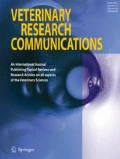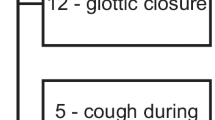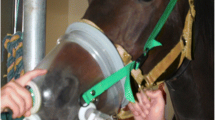Abstract
The aim of the study was to analyse the day-to-day variability of the respiratory resistance (Rrs) and the reactance (Xrs) in 5 horses in a status of remission of recurrent airway obstruction by forced oscillometry system (FOS). Furthermore, the effects of stabling, outdoor and room temperature and humidity on these parameters were determined. Mean Rrs at oscillation frequencies 1, 1.5, 2 and 3 Hz were all significantly higher in the morning than in the afternoon, while Xrs was not significantly affected by time of the day. Rrs was significantly different on various sampling days at all frequencies, in the morning as well as in the afternoon. Xrs showed the same significant differences for frequencies greater than 1 Hz. Overall, Rrs showed a smaller variability than Xrs. Neither outdoor temperature, nor room temperature affected Rrs. This also applied to Xrs except for the measurements at 2 Hz that were significantly (p = 0.044) affected by outdoor temperature. Turning out these horses at paddock for day and night caused a significant lower mean Rrs that when kept at stable for all night. While Rrs showed a very weak positive frequency dependency, Xrs clearly showed a positive frequency dependance for all horses. Resonance frequency (fres) was between 2 and 4 Hz. These studies showed that FOS generated parameters are affected by environmental and management factors and thus only after well-designed standardized procedures FOS could be a useful diagnostic tool for the diagnosis and monitoring of equine respiratory disorders.


Similar content being viewed by others
References
Art T, Lekeux P (1993) Training-induced modifications in cardiorespiratory and ventilatory measurements in thoroughbred horses. Equine Vet J 25:532–536
Derksen FJ, Robinson NE (1980) Esophageal and intrapleural pressures in the healthy conscious pony. Am J Vet Res 41:1756–1761
Desager KN, Buhr W, Willemen M, van Bever HP, de Backer W, Vermeire PA, Landser FJ (1991) Measurement of total respiratory impedance in infants by the forced oscillation technique. J Appl Physiol 71:770–776
Hoffman A, Mazan MR (1999) Programme of lung function testing horses suspected with small airway disease. Equine Vet Educ 11:322–328
Hoffman A, Mazan MR, Manjerovic N (1998) Association between airway reactivity and bronchoalveolar lavage cytology in horses with exercise intolerance. Am J Vet Res 59:176–181
Hoffman A, Kuehn H, Riedelberger K, Kupcinskas R, Miskovic MB (2001) Flowmetric comparison of respiratory inductance plethysmography and pneumotachography in horses. J Appl Phys 91:2767–2775
Hoffman AM (2002) Clinical application of pulmonary function testing in horses. In: Lekeux P (ed) Equine respiratory diseases international veterinary information service Ithaca, DocumentNo B03040802, http://wwwivisorg/special_books/Lekeux/hoffman/chapter_frmasp LA = 1, Accessed July, 2009
Jean D, Vrins AA, Lavoie JP (1999) Monthly, daily, and circadian variations of measurements of pulmonary mechanics in horses with chronic obstructive pulmonary disease. Am J Vet Res 60:1341–1346
Klein C (2002) Anwendung der impuls-oszilloresistometrie zur analyse der atmungsmechanik beim pferd. Prakt Tierarzt 83:254–256
Klein C, Reinhold P (2001) Analysis of respiratory mechanics by impulse oscillometry in non- sedated and diazepam-sedated swine. Res Vet Sci 70:181–189
Klein C, Smith HJ, Reinhold P (2006) The use of impulse oscillometry for separate analysis of inspiratory and expiratory impedance parameters in horses: effects of sedation with xylazine. Res Vet Sci 80:201–208
Landsér FJ, Clément J, Van de Woestijne KP (1982) Normal values of total respiratory resistance and reactance determined by forced oscillation: influence of smoking. Chest 81:586–91
Lavoie JP, Pascoe JR, Kupershoek CJ (1992) Effect of head and neck position on respiratory mechanics in horses sedated with xylazine. Am J Vet Res 53:1652–1657
MacLeod D, Birch M (2001) Respiratory input impedance measurement: forced oscillation methods. Med Biol Eng Comput 39:505–516
Mazan MR, Hoffman AM, Manjerovic N (1999) Comparison of forced oscillation with the conventional method for histamine bronchoprovocation testing in horses. Am J Vet Res 60:174–180
Oostveen E, MacLeod D, Lorino H, Farrè R, Hantos Z, Desager K, Marchal F (2003) The forced oscillation technique in clinical practice methodology, recommendations and future developments. Eur Respir J 22:1026–1041
Pasker HG, Schepers R, Clément J, Van de Woestijne KP (1996) Total respiratory impedance measured by means of forced oscillation technique in subjects with and without respiratory complaints. Eur Respir J 9:131–139
Roberts C, Marlin D, Lekeux P (1999) The effects of training on ventilation and blood gases in exercising thoroughbreds. Equine Vet J 30:57–61
Reinhold P, Smith HJ, Langenberg A, Lekeux P (1998) Measurement of respiratory impedance in healthy calves using the impulse oscillation technique-physiological and methodological aspects. Vet J 155:27–38
Richard EA, Fortier GD, Denoix JM, Art T, Lekeux PM, van Erck E (2009) Influence of subclinical inflammatory airway disease on equine respiratory function evaluated by impulse oscillometry. Equine Vet J 41:384–389
Robinson NE (2001) International workshop on equine chronic airway disease Michigan State University 16–18 June 2000. Equine Vet J 33(1):5–19
Robinson NE, Olszewski MA, Boehler D, Berney C, Hakala J, Matson C, Derksen FJ (2000) Relationship between clinical signs and lung function in horses with recurrent airway obstruction (heaves) during a bronchodilator trial. Equine Vet J 32:393–400
Smith HJ, Reinhold P, Goldman MD (2005) Forced oscillation technique and impulse oscillometry. Eur Respir Monogr 31:72–105
Stadler P, Deegen E (1986) Diurnal variation of dynamic compliance, resistance and viscous work of breathing in normal horses and horses with lung disorders. Equine Vet J 18:171–178
Tesarowski DB, Viel L, McDonell WN (1996) Pulmonary function measurements during repeated environmental challenge of horses with recurrent airway obstruction (heaves). Am J Vet Res 57(8):1214–1219
van Erck E, Kirschvink N, Bureau F, Art T, Lekeux P (1998) Determination of normal values of respiratory resistance with impulse oscillometry in healthy horses. In: Proceedings of the World Equine Airway Symp, Guelph, pp 33
van Erck E, Votion D, Kirschvink N, Art T, Lekeux P (2003) Use of the impulse oscillometry system for testing pulmonary function during methacholine bronchoprovocation in horses. Am J Vet Res 64:1414–1420
van Erck E, Votion D, Art T, Lekeux P (2004) Measurement of respiratory function by impulse oscillometry in horses. Equine Vet J 36:21–28
van Erck E, Votion D, Art T, Lekeux P (2006) Qualitative and quantitative evaluation of equine respiratory mechanics by impulse oscillometry. Equine Vet J 38(1):52–58
Winkler J, Hagert-Winkler A, Wirtz H, Hoheisel G (2009) Modern impulse oscillometry in the spectrum of pulmonary function testing methods. Pneumologie 63(8):461–469
Young S (1991) Long term variability of total respiratory impedance in normal ponies. J Vet Anaesth 18:15–18
Young SS, Hall LW (1989) A rapid non-invasive method for measuring total respiratory impedance in the horse. Equine Vet J 21:99–105
Young SS, Tesarowski D (1994) Respiratory mechanics of horses measured by conventional and forced oscillation techniques. J Appl Phys 76:2467–2472
Young SS, Tesarowski S, Viel L (1997) Frequency dependence of forced oscillatory respiratory mechanics in horses with heaves. J Appl Physiol 82:983–987
Acknowledgements
The authors thank Dr. Jutta Schaar for her help with the measurement and Dr. Klaus Riedelberger for his instruction on the handling of the MFOS equipment.
Conflict of interest statement
None of the authors of this paper has a financial or personal relationship with other people or organisations that could inappropriately influence or bias the content of the paper.
Author information
Authors and Affiliations
Corresponding author
Rights and permissions
About this article
Cite this article
Onmaz, A.C., Stoklas-Schmidt, C. & van den Hoven, R. Daily variability of forced oscillometry parameters in horses suffering recurrent airway obstruction, a pilot study. Vet Res Commun 37, 11–17 (2013). https://doi.org/10.1007/s11259-012-9541-y
Accepted:
Published:
Issue Date:
DOI: https://doi.org/10.1007/s11259-012-9541-y




